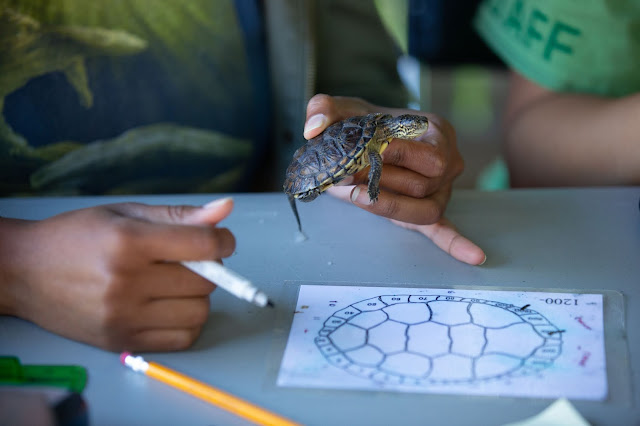Photos by Jeremy Dwyer-Lindgren/Woodland Park Zoo
On July 12, more than 45 endangered Western pond turtles were weighed,
measured and marked for identification in preparation for being released to the
wild at protected sites in Washington.
Under the Western Pond Turtle Recovery Project, the turtles
were collected from the wild as eggs and given a head start on life under the
care of Woodland Park Zoo to improve their chance of survival in the wild.
Unlike wild turtles, they are fed at the zoo throughout the
winter so that by summer they are nearly as big as 3-year-old turtles that grew
up in the wild.
 |
| Once the turtles reach about 2 ounces—a suitable size to escape the mouths of invasive predatory bullfrogs—they are returned to the wild and monitored by biologists. |
In 1991, only about 150 Western pond turtles remained in two
populations in the state of Washington and the species nearly became extinct.
In 1993, the state listed the Western pond turtle as endangered. Today, thanks
to collaborative recovery efforts over the last 27 years, more than 1,000
thrive at protected sites.
 |
| Washington Department of Fish and Wildlife biologists and zoo staff weighed, measured and marked 47 turtles. |
Over the last several years, an emerging shell disease
affecting 29 to 49 percent of the wild population threatens decades of recovery
progress. Known to cause lesions in a turtle’s shell, severe cases can lead to
lowered fitness and even death. Chicago’s Shedd Aquarium and the University of
Illinois at Urbana-Champaign have joined the recovery efforts by collaborating
to better understand the disease. The aquarium and university are looking at
the disease from a microbial and pathological perspective to better understand
its origin and the role environmental factors could play. The goal is to give
young turtles a better chance at survival in the wild.
Woodland Park Zoo and Oregon Zoo are working with Washington
Department of Fish and Wildlife and other partners to address this urgent
situation: studying the disease, treating severely diseased turtles, and
providing overwinter care for turtles to allow their shells to heal before they
are released back into the wild. After the treated turtles are released, WDFW
monitors the turtles to determine if they remain healthy and are able to
reproduce normally in the wild.
The Western pond turtle once ranged from Washington’s Puget
Sound lowlands, southward through Western Oregon and California to Baja
California. By 1990, their numbers plummeted to only about 150 Western pond
turtles in two populations in the state of Washington. These last remaining
individuals struggled for survival as they battled predation by the non-native
bullfrog, disease and habitat loss. A respiratory disease threatened the
remaining turtles and biologists could not find evidence confirming hatchling
survival.
In 1991, Woodland Park Zoo and Washington Department of Fish and
Wildlife (WDFW) joined forces to recover Western pond turtles by initiating a
head start program. In 1999, Oregon Zoo joined the recovery team and, over the
years, other nonprofits, government agencies and private partners have
contributed to the multi-institutional conservation project. In 27 years,
self-sustaining populations have been re-established in two regions of the
state: Puget Sound and the Columbia River Gorge. More than 2,100 turtles have
been head started and released, and surveys indicate that more than 1,000 of
the released turtles have survived and continue to thrive at six sites.
Each spring, WDFW biologists go in the field to attach
transmitters to adult female Western pond turtles. They monitor the turtles
every few hours during the nesting season to locate nesting sites and they
protect the nests from predators with wire exclosure cages. A portion of the
eggs and hatchlings are collected and transported to Woodland Park and Oregon
Zoos where they can grow in safety.
While slowly making its way toward recovery, the Western
pond turtle population still faces threats such as the loss of suitable
habitat, invasive bullfrog predation and disease. The Western pond turtle is
one of 19 species that are part of the Association of Zoos & Aquariums’
(AZA) SAFE (Saving Animals From Extinction) initiative, which focuses on the
collective expertise within AZA’s accredited institutions and leverages their
massive audiences to save species. AZA and its members are convening scientists
and stakeholders to identify the threats, develop action plans, raise new
resources and engage the public.
#turtlepower #savingspecies



Comments
Post a Comment